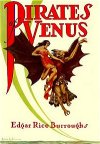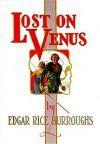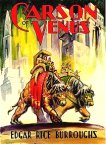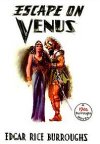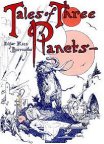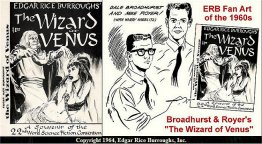Amtor Observations
The Hounds of Amtor
On Mars, John Carter had Woola, who was the closest thing
the Martians had to an earthly dog.
But were there dogs on Venus?
The closest animals the reader finds to dogs are the hunting
pack of Skor of Morov. Carson and Duare encountered them after crossing
the land of Noobol through the large, dangerous forest. "I chanced to glance
back and saw a strange animal standing on the opposite rim watching us.
It was about the size of a German police dog, but there the similarity
ceased. It had a massive, curved beak remarkably similar to that of a parrot;
and its body was covered with feathers; but it was no bird, for it went
on four legs and had no wings. Forward of its two short ears were three
horns, one in front of either ear and the third growing midway between
the others. As it turned part way around to look back at something we could
not see, I saw that it had no tail. At a distance its legs and feet appeared
bird-like." (LV, Chapter 7)
The animals voiced "a hoarse, wailing scream" which Carson
referred to as "baying." The dogs also cackled. Later, they were said to
be whistling. So on Venus, it's the dog that whistles instead of the master.
When Carson fired an arrow at one, the others attacked
and devoured it. Even on Venus, it's a dog-eat-dog world.
However, they turned out to be animals called kazars,
domesticated by Skor, who showed up shortly; Skor used the kazars for hunting
and protection.
Later, after Carson and newfound acquaintance Nalte escaped
from Skor's gloomy castle in search of the missing Duare, the duo had to
hide when they spotted Skor with his pack, apparently out hunting for all
the escapees.
That's about the last we hear of any kind of "dog" in
the Venus series until Escape on Venus, and then ERB reintroduces
them in a brief humorous reference to what sounds a lot like Earth dogs.
In the land of Brokol, where men turn dark green with
anger, and infants grow on trees, Carson briefly discussed infant mortality.
While those babies were dangling from the branches, guypals (the same flying
beasts which ravaged the pools of polly-wog people in Mypos) take their
toll. Insects are no friend of the little green babies either.
But Carson reassured the readers:
"...as the Brokols are polygamous and both the ground
and the females ex-tremely fertile, there is little danger that race suicide
will exterminate them.
"I might mention that no dogs are al-lowed in the orchards."
So, those inviting trees were not to have foreign substances
sprayed or trick-led onto them by any passing beasts who might desire to
hike a hind leg next to a tree.
No further description of thoese Brokolian "dogs" is provided,
so one might wonder: Are these "dogs" more of the kazar-like creatures,
or, was Loto-el-Hoo-Ganja Kum O Raj out walking her pregnant dog when she
(along with the animal) was mysteriously transported there from Brooklyn?
Or was Carson just inserting a little joke that ERB reported
with a straight face?
I Still Live!
ERB's Martian series probably first comes to the mind
of fans as the place to look to find the phrase, and the concept, "I still
live." Most notably, Tara of Helium breathed the exact phrase on several
occasions as she "recalled the Spartan stubbornness of her sire in the
face of certain annihilation."
But the term is really characteristic of all Burroughs
heroes and heroines, and those on Venus are no exception.
In his rocket ship, speeding toward what he thought would
be a death either from the sun's increasing heat or a deadly collision
with Venus (PV, Chapter 3), Carson mused: "Yet I was excited. I
cannot say that I felt fear. I have no fear of death -- hat left me when
my mother died; but now that the great adventure loomed so close I was
overwhelmed by contemplation of it and the great wonder that it induced.
What would follow?"
As it became more apparent that the ship would crash on
Venus, Carson got ready: "Even though I did not shrink from death... the
urge to live that is born with each of us compelled me to make the same
preparations to land that I should have had I successfully reached my original
goal, Mars."
Later, on Venus itself, Carson had been swept overboard
in a storm but had managed to stay afloat and at last was contemplating
a dangerous landing on a rocky, surf-pounded shore. "As I drew nearer it,
many things, some of them quite irrelevant, passed through my mind; but
some were relevant, among them the Burial Service. It was not a nice time
to think of this, but then we cannot always control our thoughts; however,
'In the midst of life we are in death' seemed wholly appropriate to my
situation. By twisting it a bit, I achieved something that contained the
germ of hope -- in the midst of death there is life. Perhaps --" (PV,
14)
His narration continued: "A great wave lifted me upon
its crest and carried me forward—the end had come! With the speed of a
race horse it swept me toward my doom; a welter of spume engulfed my head;
I was twisted and turned as a cork in a whirlpool; yet I struggled to lift
my mouth above the surface for an occasional gasp of air; I fought to live
for a brief moment longer, that I might not be dead when I was dashed by
the merciless sea against the merciless rocks -- thus dominating is the
urge to live."
In Lost on Venus, Chapter 22, appropriately titled
"To Live or Die?", Carson and Nalte were surrounded by zangans -- beast
men, called by Carson "Human Tigers." Both thought they were about to die.
Carson said, "I am saving the last second in which to
die. Until then I shall not admit that there is ever to be a last second
for me, and then it will be too later to matter."
Nalte said she admired him for saying that, "But at least
it will be a quick death."
After Carson loosed his last arrow, Nalte said, "Hold
me close. I am not afraid to die, but I do not want to be alone...."
Replied Carson, "You are not dead yet, Nalte." He added,
to ERB: "I couldn't think of anything else to say. It must have sounded
foolish at such a time, but Nalte ignored it."
But luckily for both, they were shortly to be introduced
to Ero Shan from Hava-too who had ridden to their rescue with a company
of men.
In Escape on Venus, Chapter 2, as Carson and Duare
battled the storm in the anotar, Duare said, "We have lived. Life can hold
nothing better for us than that which we have enjoyed. I am not afraid
to die. Are you, Carson?"
"That is something that I shall never know until it is
too late," I said, smiling down at her, "for while I live I shall never
admit the possibility of death."
In chapter 16, trying to escape the Myposans, Duare says,
"We are trapped. But at least we shall die together."
"We are not dead yet," Carson said, which is another way
of saying "We still live."
At the start of The Wizard of Venus, as Carson
and Ero Shan embark on their "misadventure," Carson speaks of life and
death another way. "I gamble with Death; my life is the stake. But I have
a grand time, and so far I have always beaten Death to the draw."
Amtor Art
Edgar Rice Burroughs may or may not have known a lot
about art, but he certainly knew what he liked -- and didn't like -- took
the opportunity to say so through the experiences of his characters.
Burroughs used instances in the Venus series to present
his low opinion of modern art and architecture, and to promote his preference
for art that he thought of as a product of true beauty and imagination.
His first opportunity comes in Pirates of Venus
when Carson goes to visit Mintep, jong of Vepaja. As he awaited his audience,
he admired the artwork:
"While I waited there,
I embraced the op-portunity to study the elaborate carvings that surrounded
the portal, forming a frame fully five feet wide. The motif appeared historical,
and I could easily imag-ine that the various scenes depicted important
events in the life of a dynasty or a nation. The workmanship was exquisite,
and it required no stretch of the imagination to believe that each delicately
carved face was the portrait of some dead or living celebrity. There was
nothing grotesque in the delineation of the various figures, as is so often
the case in work of a similar character on earth, and only the borders
that framed the whole and separted contiguous plaques were conventional."
(Chapter 4)
But, taken as a prisoner to the communist-like city of Kapdor,
he had a much dif-ferent experience: "There were a number of stone buildings
facing the streets along which I was conducted; but they were all box-like,
unprepossessing structures with no hint of artistic or imaginative genius.
In that respect they were reminiscent of the so-called modern architecture
that was just making itself felt before I left earth." (LV, Chapter
1)
In the next chapter, Carson is an escaped prisoner and
viewing the city on his own. He said, "I took the time now to investigate
the room, on the chance that it might contain something else of use or
value to us in our bid for liberty. It was a rather large room. An attempt
had been made to furnish it ornately, but the result was a monument to
bad taste. It was atro-cious." Even in the midst of seeking a weapon to
help flee a dangerous city, Carson took time to comment on the decor.
In Havatoo, Carson was much more impressed: "The gate
itself was of magnificent proportions and an architectural gem, bespeaking
a high order of civilization and culture. The city wall, of white limestone,
was beautifully carved with scenes that I took to portray the history of
the city or of the race that inhabited it, the work having apparently been
conceived and executed with the rarest taste; and these carvings extended
as far as I could see." (LV, Chapter 11)
ERB seems to have most of his fun with art -- good and
bad -- in Escape on Venus. In chapter 4, in Mypos, the city of amphibious
people, "We passed along narrow, crooked streets flanked by one storied
houses built of frame or limestone. The former were of roughly split planks
fastened to upright framework, the latter of carelessly hewn blocks of
limestone. The houses were as crooked as the streets. Evidently they had
been built by eye without benefit of plumb-line. The windows and doors
were of all sizes and shapes and all manner of crookedness. They might
have been designed by a modernist of my world, or by a child of five."
Fishy taste in art appreciation
Burroughs, via Carson, rubs it in with:
"The Myposans have little
or no sense of the artistic. They seem to be form and line blind. Their
streets are crooked; their houses are crooked. The only harmony that abounds
is that of disharmony. The palace of Tyros was no exception. The throne
room was a shapeless, polyangular space somewhere near the center of the
palace. In some places the ceiling was twenty feet high, in others not
much more than four. It was supported by columns of different sizes, irregularly
spaced. It might have been designed by a drunken surrealist afflicted with
a hebephrenic type of dementia praccox; which, of course, is not normal,
because surrealists are not always drunk." Chapter 14
After Duare rescued Carson from Bro-kol, they continued on
their quest for Sanara, and as they flew over the Venusan landscape, ERB,
through the voice of Carson, praised one of his favorite artists -- Nature
itself. This time, he used it as a comparative in getting in another dig
at modern art:
"There is something strangely
beautiful about an Amtorian landscape, beautiful and unreal. Perhaps it
is the soft, pastel shades, that make it look more like a work of art than
a creation of Nature. Like a gorgeous sunset on Earth, it is something
that could never be reproduced by man. I sometimes think that man's inability
to reproduce the beauties of Nature has led to the abominable atrocities
called modern art." (EV, Chapter 30)
Perfect... but flawed
Then in the next chapter, in an unplanned stop in the
city of Voo-ad, Carson and Duare are treated to the Voo-adian idea of art.
On a tour of the city, their guide "...took us into an art shop where the
work of the best artists of Voo-ad was on exhibition. These people show
remarkable aptitude in reproducing natural objects with almost photographic
fidelity, but there was not the slightest indication of creative genius."
ERB seems like a hard art critic to please. However, we soon learn that
the Voo-adians know only one thing, and that's how to make exact copies
of everything, including themselves!
Says Ero Shan, while "hanging around" with Carson and
Duare, "...they have no creative genius in art or letters; they can copy
beautifully, but are without imagination, except of the lowest order."
So, ERB likes realistic art influenced by some imagination,
but not to the point of being grotesque.
In the final major land Carson and Duare visit in Escape,
the only art that is found is the art of war, followed by the art of the
Pangan girls, who manage to do what their men couldn't—artfully bring about
the defeat of the conquering Falsan army by getting the foolish troops
drunk!
Finally in that book—people who exer-cise an effective
form of art!
Venus: The Room of the
Eight Doors
In 1882, Frank R. Stockton wrote the classic short story,
"The Lady or the Tiger," about a barbaric king who had devised an unusual
method of meting out "justice." Those in his disfavor were placed in an
arena and given a choice of two doors to open. One hid a lady, whom he
would wed and live free. The other contained a ravenous tiger, which would
rend him and eat him.
The "behind that door" tease has always been popular.
A more recent and less dangerous version was Monty Hall's television game
show, "Let's Make a Deal," with contestants given a choice of at least
three doors, behind which stood either a wonderful prize worth thousands
of dollars, or something much less desirable, such as a goat or a coop
full of chickens. Sometimes, after a contestant had chosen his door, but
while it was still closed, Monty would then introduce a fourth option,
calling for a curtain to be opened which would show a nice alternate prize,
or offering a handful of cash, and telling the contestant he could either
have that or whatever was behind his unopened door.
Thus, the agony of choice was amplified.
In the opening of Lost on Venus, Carson Napier was placed
in The Room of the Seven Doors in Kapdor, the Thorist-allied city in the
land of Noobol. The odds were pretty much against Carson, because only
one of the seven doors led to life, while different kinds of barbaric death
lurked behind the other six, including a tharban, the Amtorian equivalent
of a tiger.
In addition, they added to the mix of choices by including
a table with seven drinks and seven plates of food. Six of the seven drinks
would be fatal, just as were six of the seven choices of doors. In the
mat-ter of the food, the odds were different: Six of the food dishes were
edible; only one was poisoned.
Still, the food didn't offer a very ap-pealing choice
-- like playing Russian rou-lette and spinning the cylinder of the revolver,
hoping that the chamber with the bullet did not come up.
At least one other obvious option presented itself, though:
A rope ending in a noose, suspended above the table on which the food sat.
The rope wasn't positioned to where he could manage to snap his neck, but
where it would allow him only to slowly strangle to death.
Well, suppose he decided to do nothing? Just sit there
and wait for whatever.
His captors had thought of that, too, and after a time
released all manner of snakes, including one giant-size one, into the room
to help hasten his decision.
His decision was to "go for it" and open one of the doors
and to jam it open with a spiked chair that had been left in the room to
further torture him. This proved to be the door behind which the tharban
lurked but, to Carson's good fortune, when it charged out it got into a
battle to the death with the big snake.
The snake won, then started for Carson once again. Having
few alternatives, he began ascending the rope, and here was exposed the
flaw in the chamber of horrors, a flaw which perhaps no one else had ever
discovered. The rope was attached at the top to a beam, and walking along
the beam Carson came to the walls at the top of the chamber and found an
eighth door in The Room of the Seven Doors, this one apparently left by
construction crews, and it led to the roof and freedom.
Was that a deus ex machina or a more satisfactory
way of escaping this dilemma? The reader must decide, but escape he did
and Carson soon was "lost on Venus," which turned out to be a better deal
than losing his life.
There seems to be one other thing lacking in The Room
of the Seven Doors. There was no place for spectators to gloat over the
agony of the victim. At least, there were no spectators that were readily
visible to Carson. If there were secret viewing ports, they apparently
weren't being used, since no alarms were raised when Carson shinnied up
the hangman's rope and found his own way out of the vault of horror.
The jong of Kapdor had taken fiendish delight in telling
Moosko about the horror of The Room of the Seven Doors, so you would think
these warped people would have had a way of delighting in their torture
by watching it. But apparently not, and lucky for Carson they didn't!
Now for an exercise in "what if." Fans often wonder why
Carson didn't use his telepathic powers more often to get him out of pickles
on Venus. Probably because it would have made the stories a lot less exciting.
Here's a short little example I wrote back in 2007:
The Room with the Seven Doors
Carson Napier was trapped in The Room of the Seven Doors.
Behind one door lay freedom; behind the other six lay fates too horrible
to contemplate.
"No problem," he smiled. "I'll just turn on my nifty
little hallucinatory powers."
He concentrated, and soon those outside the Room saw Carson
standing next to them, grinning triumphantly. Then, the vision disappeared.
"What's going on," demanded one guard.
"I don't know, let's check the room," said the other.
They opened the door to the Room and ran in; Carson, hiding
behind the door, conked them on their heads and then made his escape.

